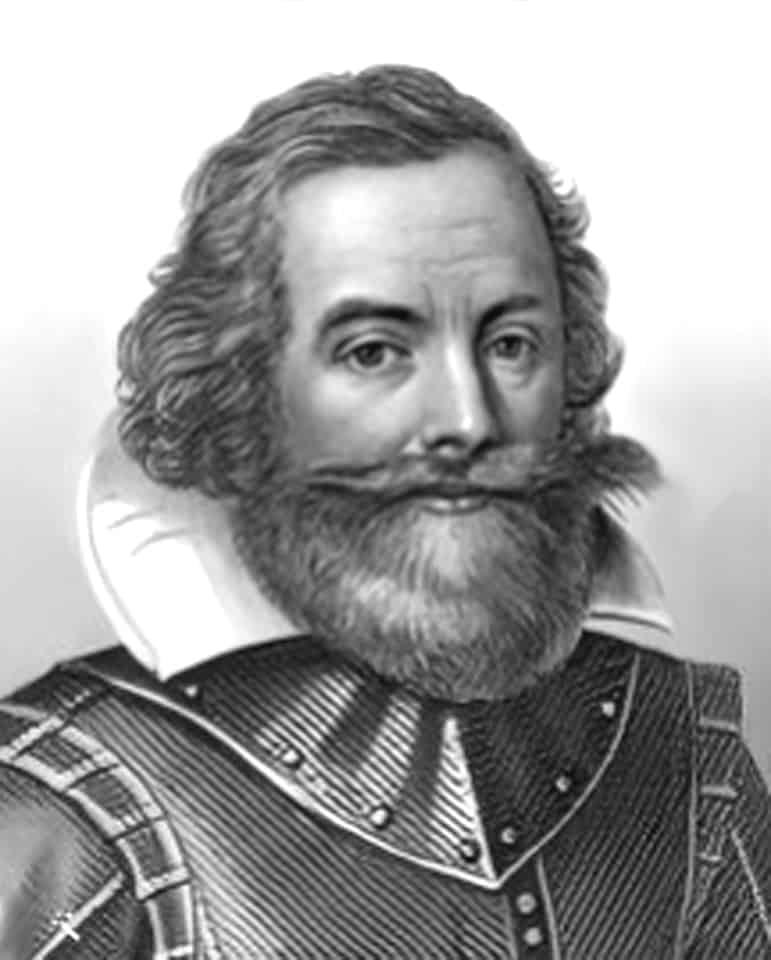By Inna Babitskaya
Malden is one of the most ancient cities in Massachusetts, New England and the USA. It was incorporated as a town 375 years ago, on May 2, 1649. But the first English settlers in the area of a future Malden appeared 400 years ago, in 1624. An exploration of the future state of Massachusetts began even 10 years earlier (in 1614/15) – by the famous mercenary, adventurer and cofounder of Virginia’s colony Captain John Smith (1580–1631), who can be considered the godfather of New England.
When Smith saw the entrance to Boston Harbor, he erroneously decided that it was the estuary of a large water artery and named it Charles River, in honor of the Prince of Wales and the future king Charles I. Also, the prince’s name was given to the first settlement on the south bank of the Charles River. As he mentioned in the “Advertisements for the Inexperienced Planters of New England,” “I took the fairest reach of this bay for a river… that fair channel to divide itself into so many fair branches as made forty or fifty pleasant islands within that excellent bay, where the land is of divers and sundry sorts, in some places very black and fat, in others good clay, sand and gravel, the superficies neither too flat in plains, nor too high in hills.”
Smith named the whole discovered territory “New England.” This land fascinated the experienced traveler, who wrote in his book “A Description of New England” (1616) that “the country of Massachusetts is the paradise of all those parts, for here are many isles, all planted with corn, groves, mulberries, salvage gardens, and good harbors.” He described the inhabitants, fauna, flora, soil and climate of that region, underlining its trading and strategic importance for England. He told: “First, the ground is so fertile that questionless it is capable of producing any grain, fruits, or seeds you will sow or plant… All sorts of cattle may here be bred and fed in the isles or peninsulas securely for nothing. In the interim till they increase, if need be (observing the seasons)… In March, April, May, and half June here is cod in abundance; in May, June, July, and August, mullet and sturgeon, whose roes do make caviare and puttargo… In the end of August, September, October, and November you have cod again to make cor-fish or poor-john… so that half the labor in hooking, splitting, and turning is saved…”
Because of Smith’s publications, Pilgrims and Puritans knew that life in the New World required a lot of effort and hard work. He advised the future New England colonists: “In the isles you may keep your hogs, horse, cattle, rabbits, or poultry secure for little or nothing, and to command when you list; only having a care of provision for some extraordinary cold winter. In these isles, as in the mainland, you may make your nurseries for fruits and plants where you put no cattle; in the main you may shape your orchards, vineyards, pastures, gardens, walks, parks, and cornfields out of the whole piece as you please into such plots, one adjoining to another, leaving every of them environed with two, three, four, or six, or so many rows of well grown trees as you will, ready grown to your hands…Now in New England the trees are commonly lower, but much thicker and firmer wood, and more proper for shipping…”
Smith’s books inspired the immigration to America. According to him, “Here every man may be master and owner of his own labor and land… If he has nothing but his hands, he may…by industry quickly grow rich.”
Smith’s stories about America were especially valuable, because, contrary to the instructions of the voyages’ sponsors, he did not try to hide the difficulties. Smith’s descriptions and maps of New England helped many immigrants a few years later. Gradually, Puritans in England and expatriates in European countries began to obtain royal charters to colonize America, organizing joint ventures, such as the Plymouth Council of New England, the Dorchester Company, the New England Company and the Massachusetts Bay Company.
The name “New England” was officiated on November 3, 1620, in a royal charter for the Plymouth Council for New England, a joint-stock company founded for colonization and ruling the region. King James I granted to the Council the territory lying between 40–48 degrees north latitude and in length by all this breadth throughout the main land, from sea to sea. In 1621/22, Plymouth colonists occasionally visited the future Boston harbor.
Among those who played a significant role in the foundation and development of Massachusetts were Sir Ferdinando Gorges and his sons, Rev. John White, Sir Robert Saltonstall and a few others.
Sir Ferdinando Gorges (1565–1647) was a military commander, who, for his honorable service in the royal navy during the war with Spain, in 1604 was appointed the governor of Plymouth. In 1620 he, together with several associates of the Plymouth Company, organized the Council for New England, which, by the royal patent of November 3, 1620, got a grant for the territory between modern Philadelphia and St. John’s, Newfoundland. He planned to establish the aristocratic, Anglican province and to distribute the land among the council’s 40 members, who could create manors and fiefs. The Council existed until 1635 and provided basis for the foundation of the Plymouth Colony, Massachusetts Bay Colony, the New Haven Colony, the Province of New Hampshire and the Province of Maine.
In 1622, Gorges and Capt. John Mason (1586–1635), Governor of Newfoundland (1615–21), got a sub-grant for the future province of Maine, between the Merrimack and Kennebec Rivers. In 1629, Gorges and Mason divided the colony, with Mason’s portion south of the Piscataqua River becoming the Province of New Hampshire, which included most of the southeastern part of the current state of New Hampshire and portions of the present-day Massachusetts north of the Merrimack. Mason was named “Founder of New Hampshire” and appointed first vice-admiral of New England in 1635, though he never set foot in New England. He died that same year while preparing for his first voyage to the new colony.
Sir Ferdinando Gorges became known as the “Father of English Colonization in North America” and the founder and governor of Maine. He also never visited New England.
On December 30, 1622, his son, Robert Gorges (1595–1629), a veteran of Venetian wars, received a grant for the land “upon the north-east side of the Bay,… known as Messachusett,” including the rivers, islands, shores and coast, “for ten English miles towards the north-east,” and “thirty English miles unto the main land, through all the breadth aforesaid.” This land grant “extended from the Charles River ten miles north toward Salem” and included the future Charlestown. According to William Bradford, “About the middle of September [1623], this expedition arrived with “Captain Robart Gorges in the Bay of Massachusetts, with sundry passengers and families, intending there to begin a plantation.”
In 1623, Robert Gorges was appointed by the Plymouth Council as Lieutenant-General of New England. He had a personal grant of a tract of land on the northeast side of Massachusetts Bay (from the Charles River 10 miles north toward Salem, including Charlestown, Chelsea, Revere, Winthrop and East Boston) in consideration of his father’s services to the company.
On March 18, 1623, Edward Cox and other members of the New England Council decided “to join Captain Robert Gorges in his New England plantation.”
In September 1623, Robert Gorges, with a few immigrants from England, built a settlement at Wessagusset (Weymouth). However, his efforts to establish a prosperous colony failed, maybe due to his outdated attitudes toward colonists and colonization that were based on feudal traditions. He considered the settlements as aristocratic undertakings and proposed that settlers should be regarded as tenants, not as landholders, and that they should be tied to the land where they were “planted.” Such views contradicted those of the Pilgrims and Puritans, who considered themselves freemen and free owners of the land.
After working for a year on establishing a colony, Robert Gorges returned to England, appointing agents to take care of his property. Most of the settlers returned with Gorges to England – “Some out of discontent and dislike of the country, others by reason of a fire that broke out and burnt the houses they lived in and all their provisions.”
William Bradford (1590–1657) – governor of the Plymouth Colony and commissioner and president of the United Colonies of New England (that included Massachusetts Bay Colony, Plymouth Colony, Saybrook Colony (Connecticut) and New Haven and existed from 1643 till the early 1680s) – wrote with some irony: “The Governor [Robert Gorges] and some that depended upon him returned for England, having scarcely saluted the country in his government, not finding the state of things here to answer his quality and condition.”
To be continued…
(Inna Babitskaya is a Malden historian, member of the Malden Historical Commission and author of historical books “From Maldon to Malden,” “Time of Converse” and “Fellsmere Park – Emerald of Malden.”)




